“Jagannatha Trio” has been added to your cart.
View cart
-
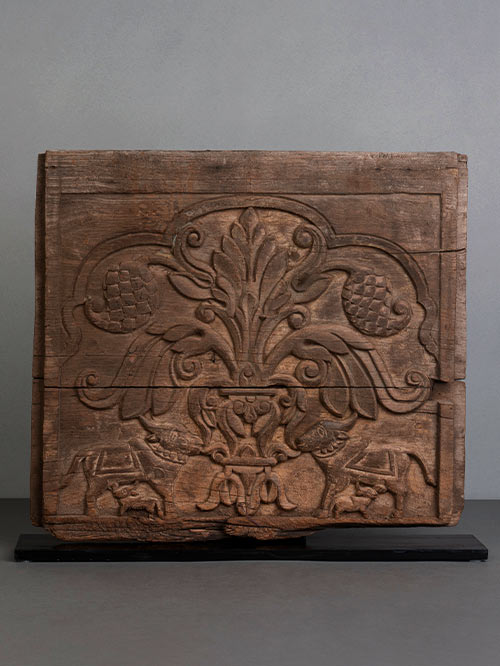
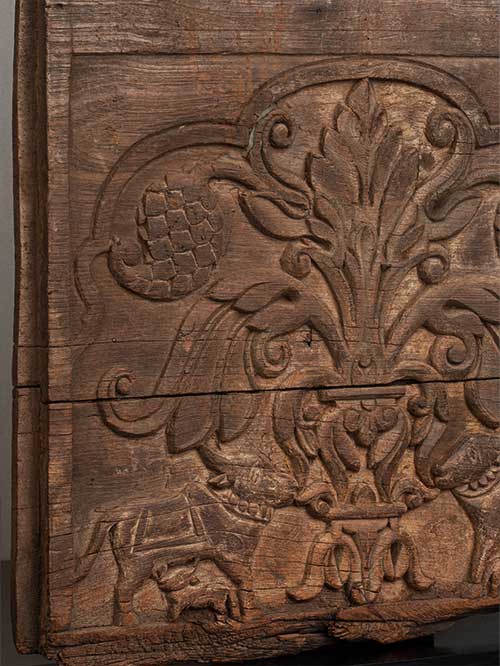
Deccan
Wood
This exemplary carved panel is delicately adorned with a central floral sprig, from which two custard apples (sitaphal) gracefully sprout. Beneath them, a pair of domesticated bulls graze on the low-hanging leaves, while a pair of diminutive calves suckle at their teats. The scene is enclosed within a trefoil archway.
Wooden construction was once widespread throughout most of Southern India, but the intense heat and the severe monsoonal rains have meant that a large proportion of the wooden buildings in private and public use have now disappeared. The typical southern Indian wooden building, was supported on a framework of columns, with an elaborate system of interlocking brackets and beams to support the floors and roofs. Carved doors, windows, and screens and panels filter light and ventilate the interiors, creating an environment that is both comfortable and richly detailed. The scale and shape of houses was dictated by the maximum height and span of timber beams, resulting in a modular system of construction. The woodwork was deeply cut and naturalistic, the intention of the artisans was to capture the forms and energies of the natural world. Panels such as these, with floral medallions radiating in full bloom or others with elaborate geometric modelling, ornamented of palaces, houses and temples.
Size (cms): 43(H) x 51(W) x 9(D)
Size (inches): 17(H) x 20(W) x 3.5(D)
-
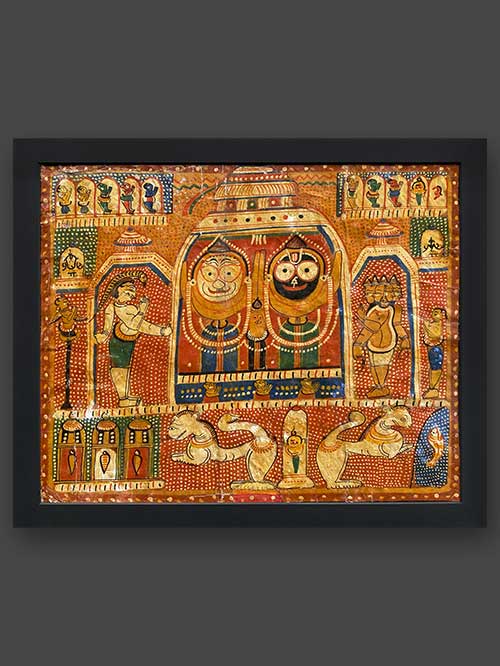
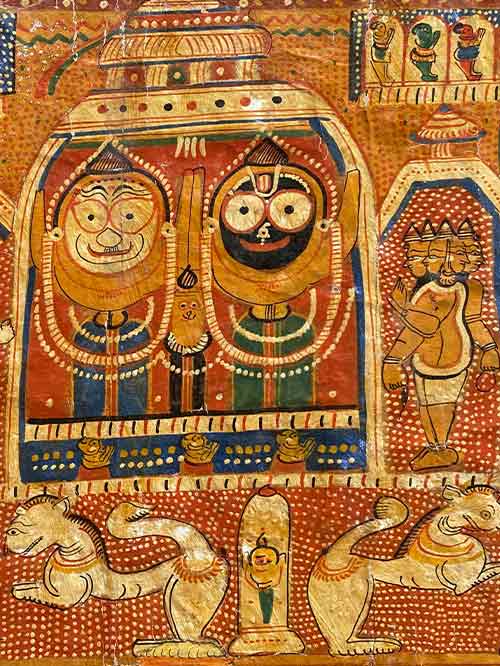
Orissa, Puri district
Gouache and lacquer on cotton cloth
The Jagannatha temple complex dominates the diagram, featuring the central shrine within a towering shikhara. Two male figures, Jagannatha and Balabhadra, are depicted dancing with raised yellow wing-like ‘arms’, while the female Subhadra stands between them. Below the central shrine, panels show priests with hands joined in prayer. To the left of the central trio is Shiva, portrayed in white with a serpent crown, also in a prayerful pose. On the right, multi-headed Brahma is depicted, offering reverence to the central deities. At the base of the temple, a pair of leogryphs forms the Lion Gate, with a small image of Jagannatha enclosed in a shrine inbetween. Flanking the temple shikhara at the top are the ten avatars of Vishnu, with Jagannatha replacing Buddha as the ninth avatar.
Puri painting, one of India’s oldest popular iconic traditions, is associated with the regional cult of Jagannatha, a manifestation of the god Vishnu, and with the ancient pilgrimage centre of Puri in Orissa on the eastern coast of India on the Bay of Bengal, where the cult took hold. The painting tradition evolved to serve the cult, with painters playing an important role. This type of painting was produced for pilgrims to carry home for display and private worship of the Jagannatha trinity. The image also provides pilgrims with a visual aid to remembering and renewing the entire pilgrimage experience, that is, visiting not only Jagannatha temple but also other shrines in the environs and being present for various daily or festival ritual activities.
Size (cms): 33.5(H) x 41(W)
Size (inches): 13(H) x 16(W)
-
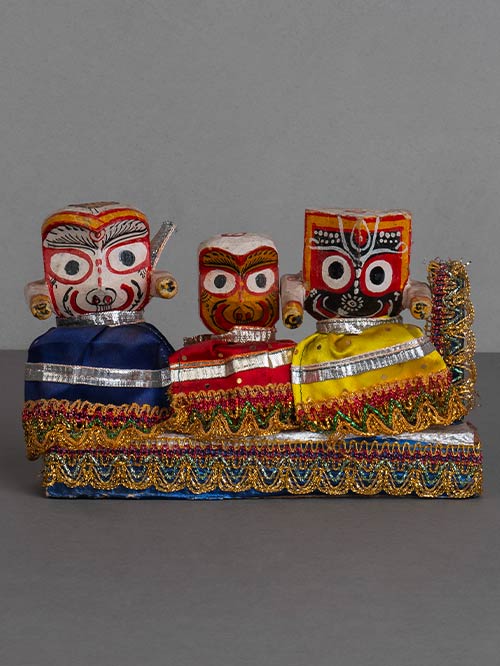
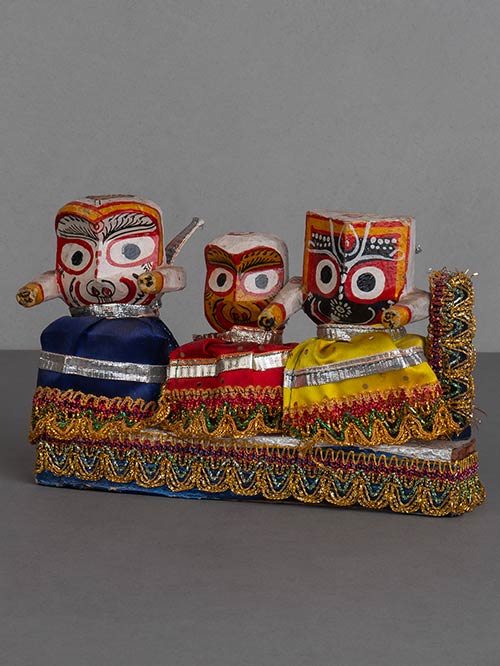
Puri (Orissa)
Wood, polychromed
In the heart of Puri lies the ancient pilgrimage centre and temple of the Jagannatha cult. There, Jagannatha, a form of Krishna, the eighth incarnation of Vishnu, is worshipped along with his brother Balabhadra and sister Subhadra. These diminutive portable figures were produced in the markets surrounding the Jagannatha temple and bought by pilgrims on their journey home. The figures are depicted as legless posts surmounted by large heads. Jagannatha (black faced) and Balabhadra (white faced) and the petite Subhadra (yellow faced).
The cult of Jagannatha in Puri is one of India’s oldest popular iconic traditions. Puri lies in Orissa is on the eastern coast of India in the Bay of Bengal. The figures of the gods remain in the temple for most of the year, but in the rainy season (June or July), they are installed in huge chariots and pulled through the streets of Puri to another temple, allowing the public to have Darshan (‘a holy view’) of the deities as they pass. It is from the huge chariots carrying Jaganath and his siblings that the English word ‘Juggernaut’ originates. Smaller figures such as these may have been used in home altars or shrines.
Size (cms): 14(H) x 21(W) x 5(D)
Size (inches): 5.5(H) x 8.5(W) x 2(D)







